What are Rollups? Everything You Need to Know

Disclaimer: Your capital is at risk. This is not investment advice.
Addressing the shortcomings of Ethereum, Layer-2 blockchain scaling platforms continue to gain prominence and popularity in the crypto space. Powered by Rollup technology, these platforms have brought faster transaction speeds and reduced costs, thereby significantly enhancing the overall Ethereum user experience. This has led to increased interest and adoption of Layer-2 platforms among developers, as they provide a viable and scalable solution for building applications on the Ethereum network. This article will delve deeper into Rollups and explore their significance within the Ethereum ecosystem.
Introduction
Layer-1 blockchains like Ethereum can sometimes be incredibly expensive and slow to use. This is particularly evident during periods of heightened network activity.

Coupled with frustratingly slow transaction processing times, the daily average fees on Ethereum skyrocketed to as high as $196 during times of congestion. Despite being a leading blockchain platform, the average transaction cost was around $40 from January 2021 to May 2022. These exorbitant fees make Ethereum almost impractical and unaffordable for many users.
To tackle this, Layer-2 platforms incorporating Rollup technology have emerged as one of the most efficient solutions. Despite the crypto winter, the leading Rollup-based platforms Arbitrum and Optimism have observed steady growth in network usage since early 2022.
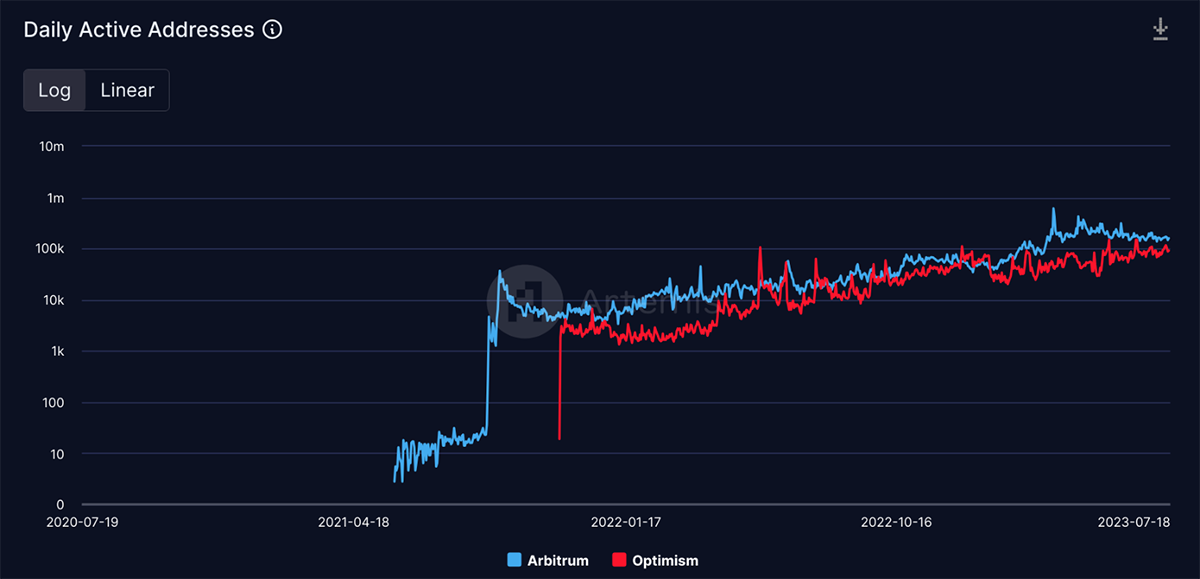
In comparison to the Ethereum mainnet, these Layer-2 platforms offer significantly reduced fees. As of 15 June 2023, platforms like Arbitrum have already saved users over $1.8bn in gas fees, owing to the implementation of these cost-effective fee models.
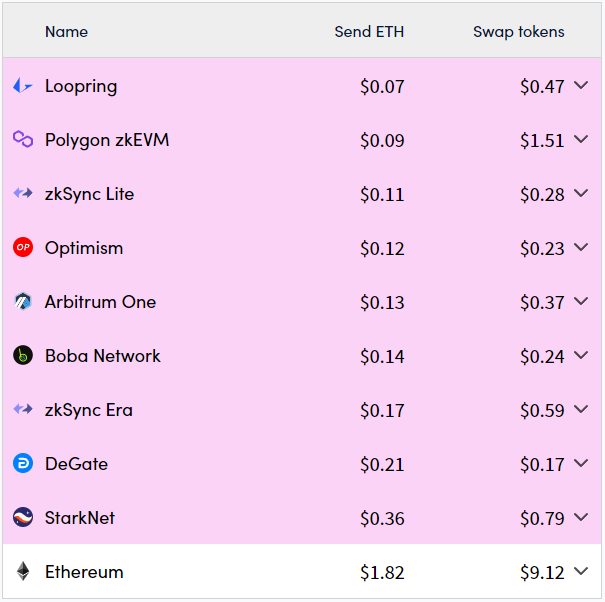
What Is Layer-1 and Layer-2 Scaling?
As the name suggests, Layer-1 scaling means upgrading and introducing new features to the base layer (Layer-1), which in this context is Ethereum, improving the overall network capacity and throughput. Recently, Ethereum has undergone significant network upgrades known as The Merge and Shanghai Hardfork. These upgrades facilitated the network transition from Proof of Work (PoW) consensus to Proof of Stake (PoS) and enabled the un-staking of Ether from the beacon chain. These individual upgrades are all part of ETH 2.0, Ethereum’s Layer-1 scaling and development roadmap, which will see many other developments and major upgrades in the future.
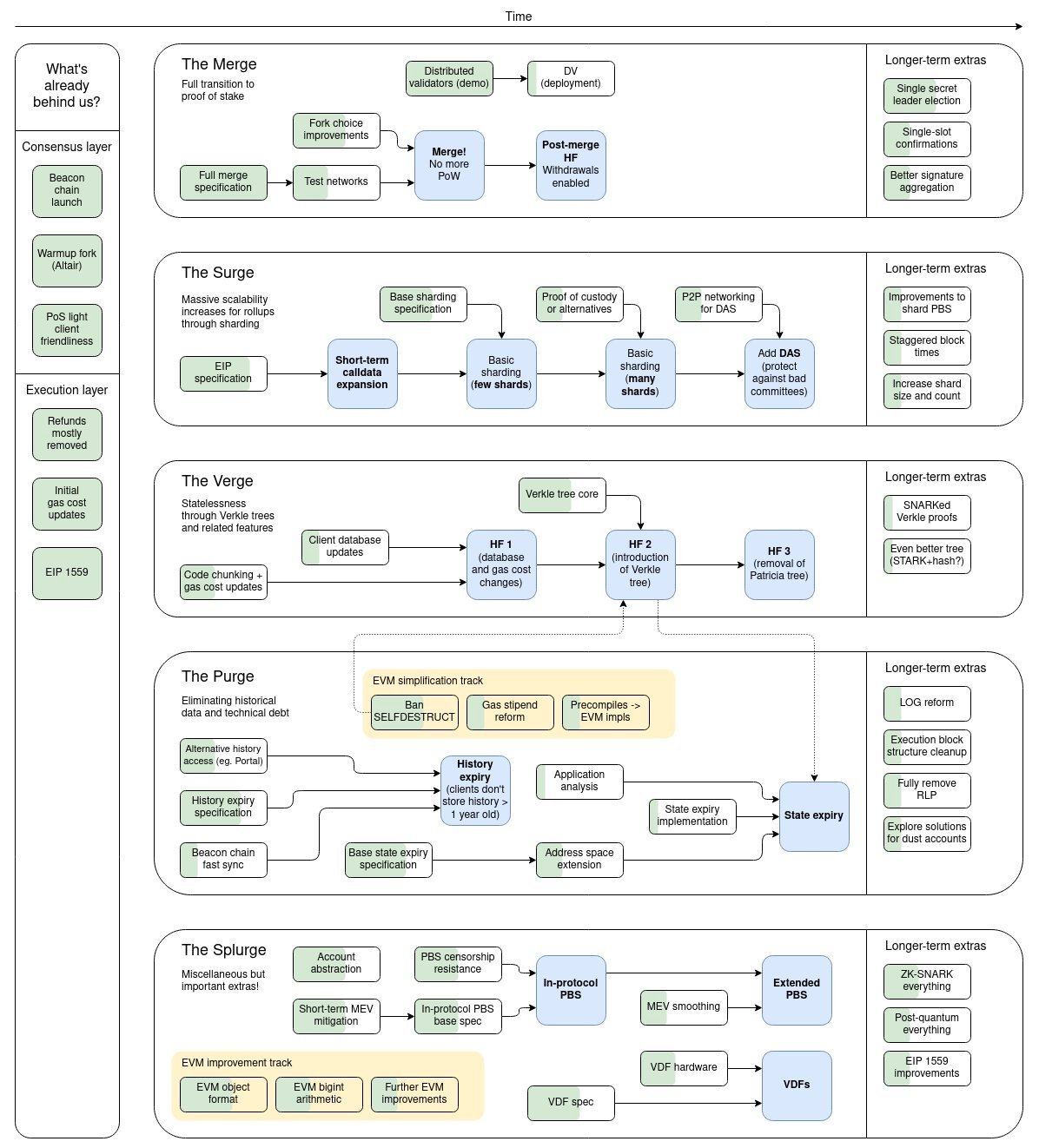
Layer-2 scaling refers to a set of solutions and techniques designed to enhance the scalability of the base layer by adding an additional layer on top of the base layer (Layer-1). These scaling solutions typically involve the use of off-chain networks or protocols that handle and process the transaction burden and then settle them on the Layer-1 base layer. State Channels, Side Chains and Rollups are the prominent types of Layer-2 scaling solutions. In this article, we will take a closer look at Rollups.
How do Rollups Work?
Rollups are an innovative technique that involves grouping multiple transactions together and processing them outside of the main chain (Layer-1 chain). This off-chain processing allows for enhanced efficiency and scalability in transaction handling by alleviating the computational burden on the main chain. By aggregating transactions and conducting verification off-chain, Rollups offer substantial improvements in scalability and throughput capacity while simultaneously leveraging the robust security and decentralised nature of the main chain.
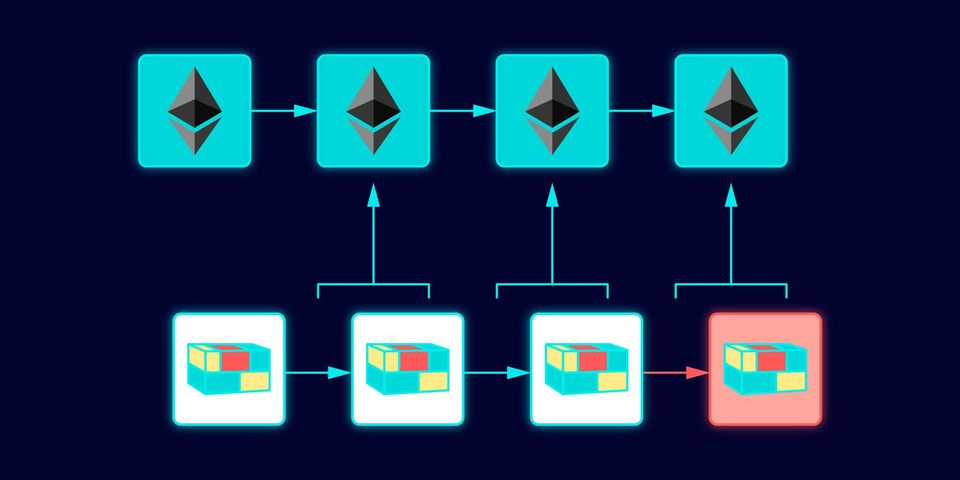
With their ability to compress transaction data into summarised forms, Rollups achieve streamlined processing while maintaining the integrity of the overall network. This approach not only facilitates faster and more cost-effective transactions but also opens up possibilities for the seamless integration of complex smart contracts and decentralised applications. By embracing Rollup technology, blockchain networks can unlock new levels of scalability and performance while staying true to the core principles of security and decentralisation.
Currently, there are two main types of Rollups: Optimistic Rollups and Zero-Knowledge Rollups.
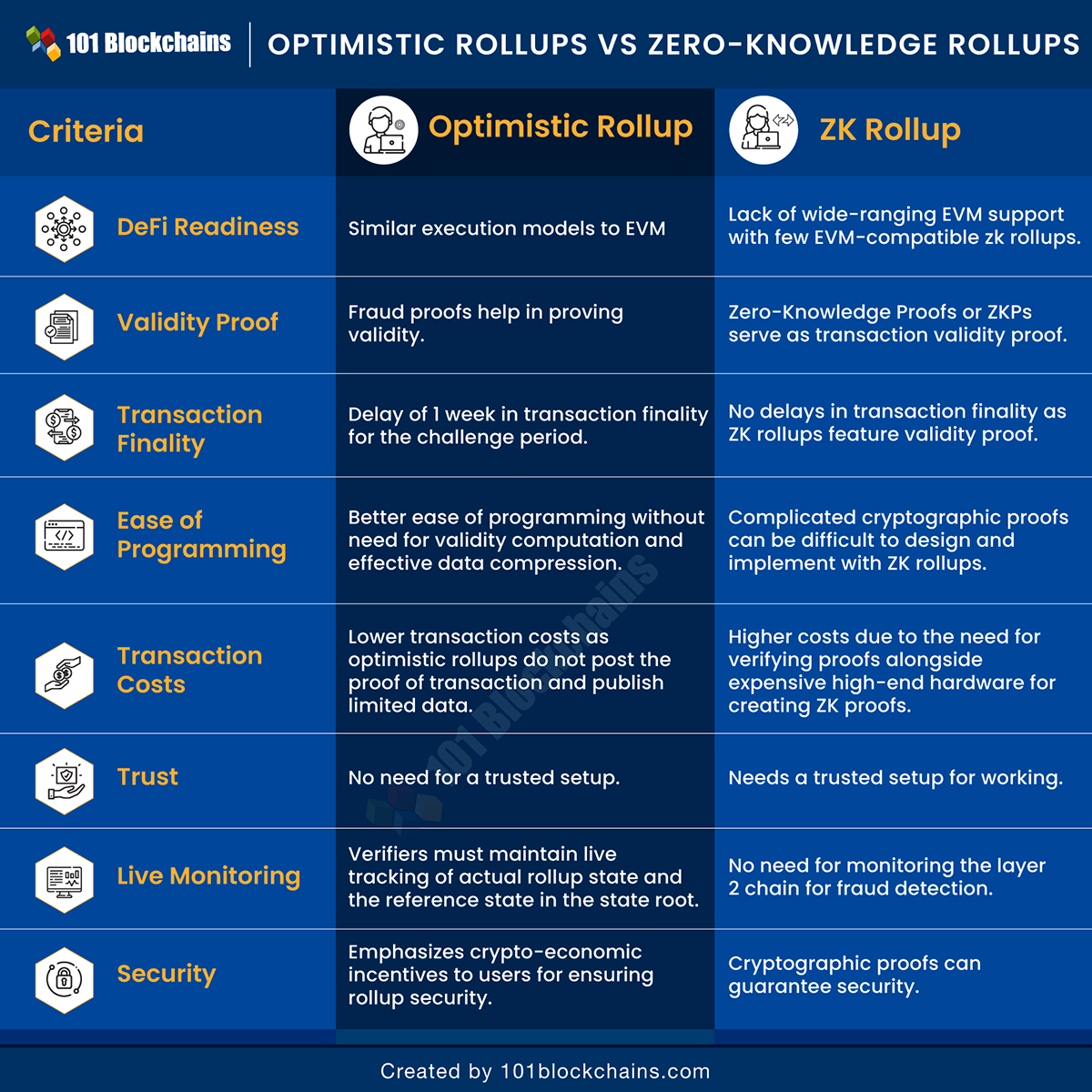
Optimistic Rollups
Optimistic Rollups are referred to as “optimistic” because they operate on the assumption that off-chain transactions are valid and do not need to publish on-chain proofs of validity for transactions, only resorting to on-chain verification if a dispute arises. Meaning unless someone initiates a dispute, this approach allows for significantly faster and more efficient transaction processing by reducing the traditional computational work required by the Layer-1 to validate the transactions. However, if a dispute does occur and users report/claim fraudulent activity, the operators have to submit validity proofs of the transactions being challenged. The challenge period is typically 1 week.
With first mover advantage, Optimistic Rollups are used by both the leading Layer-2s, Arbitrum and Optimism, in their core architecture. With an impressive TVL of $5.77bn, which represents 60% of the TVL in the Rollups space, Arbitrum stands as the clear market leader, followed by Optimism, which holds a 22% market share with a TVL of $2.14bn. These figures underscore the significant adoption and trust placed in Optimistic Rollups, solidifying their position as the go-to scaling solution for users and developers seeking improved scalability and efficiency on the Ethereum network.
Zero-Knowledge (ZK) Rollups
Unlike Optimistic Rollups, ZK-Rollups do not have any dispute resolution process. Instead, they use complex cryptography called zero-knowledge proof to create a trustless environment. Zero-knowledge proofs allow the system to mathematically prove that a given statement is true without revealing any additional information. In context, zero-knowledge proof demonstrates that the given batch of transactions is valid and adheres to the predefined rules without revealing any sensitive information about individual transactions.
However, ZK-Rollups are more expensive to develop, and they typically require additional off-chain computational capacity. Hence, the adoption of ZK-Rollups has significantly fallen behind that of Optimistic Rollups. According to l2beat, ZkSync is the largest ZK-Rollup-based Layer-2 platform, with a TVL of $635m (translating to a 6.67% market share). Loopring (1% market share), StarkNet (0.76% market share) and Polygon zkEVM (0.53%) are some of the other well-known ZK-Rollups-powered Layer-2s.
How to Use Rollups on Ethereum
Using Rollups is like using any dApp in the ecosystem, and both Optimistic and Zero-Knowledge Rollups work in a similar way. Here’s a step-by-step guide:
- Fill your crypto wallet: Load your crypto wallet, such as MetaMask, with Ether or any tokens that are compatible with the Ethereum blockchain.
- Connect to the Layer-2 network: Switch your wallet's network to the specific Layer-2 network associated with the Rollup solution you want to use. Connect your wallet by clicking on the "connect wallet" option provided.
- Bridge your tokens: Initiate the process of bridging your tokens from the Ethereum mainnet to the Rollup network. This involves paying an Ethereum transaction fee to facilitate the transfer.
- Perform transactions on the Rollup: Once your funds are successfully transferred to the Rollup network, you can engage in various activities, such as trading, interacting with dApps, or sending transactions within the Rollup ecosystem.
It's essential to consider that, although Rollups inherit Ethereum's fundamental security features, they do present certain risks compared to Ethereum's mainnet. One notable factor is the possibility of encountering bugs in Rollup smart contracts, which is no different from any other program developed on the Ethereum platform. While measures such as fail-safes and audits can reduce the likelihood of exploits, the inherent risk of relying on an external program for transaction handling remains present. Still, the steady growth in Rollup users suggests that many feel the reduced fees and increased speed outweigh the risks.
Conclusion
The emergence of Layer-2 scaling platforms within the Ethereum ecosystem represents a significant advancement in the network's evolution. These platforms empower developers to construct more scalable and efficient applications while providing users with improved transaction speeds and lower fees. By leveraging Layer-2 solutions, Ethereum addresses its scalability challenges and enhances the overall usability and performance of the network, increasing its viability as the leading smart contracts blockchain.
It's important to note that Ethereum is currently undergoing significant upgrades to address its scalability challenges, with ETH 2.0 being developed and rolled out. Layer-2 solutions complement these upgrades by providing intermediate scaling solutions and supporting Ethereum with additional computing capacity. Even with future developments, there will always be a market where Ethereum can benefit from the extra computing support provided by a Layer-2 solution.
As projects and users increasingly migrate to Layer-2 solutions, the Ethereum network becomes more robust, accommodating a broader range of applications and a larger user base. The rise of Layer-2 scaling platforms marks a significant milestone in Ethereum's evolution, positioning it as a leading blockchain platform that can meet the demands of the growing decentralised ecosystem and drive mainstream adoption of blockchain technology.

Comments ()